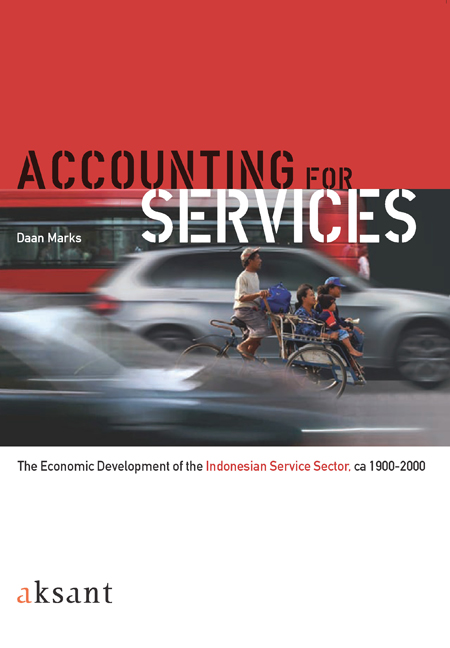Book contents
- Frontmatter
- Contents
- List of Tabels
- Acknowledgement
- 1 Introduction
- 2 National Accounting for Services in Indonesia
- 3 The Development of the Indonesian Service Sector: A Quantitative Analysis
- 4 Roads to Riches? Transportation and Economic Development in Indonesia
- 5 Involution and Growth: the Ambiguous Role of the Trade Sector in the Economic Development of Indonesia
- 6 Unity or Diversity?: Market Integration through Trade and Transport
- 7 Conclusions
- Appendices
- References
Appendix 3 - National Accounting for Government Services
Published online by Cambridge University Press: 19 January 2021
- Frontmatter
- Contents
- List of Tabels
- Acknowledgement
- 1 Introduction
- 2 National Accounting for Services in Indonesia
- 3 The Development of the Indonesian Service Sector: A Quantitative Analysis
- 4 Roads to Riches? Transportation and Economic Development in Indonesia
- 5 Involution and Growth: the Ambiguous Role of the Trade Sector in the Economic Development of Indonesia
- 6 Unity or Diversity?: Market Integration through Trade and Transport
- 7 Conclusions
- Appendices
- References
Summary
The conventional practice in national income estimation is to evaluate government services – other than those of government enterprises – in terms of expenditures made for them. Government activities can best be split into administrative and commercial activities. The former are valued at the cost of these services, that is, as equivalent to the wages and salaries paid by government administrative departments and the latter on the same basis as other productive enterprises. The government sector includes public administration under government services. Railways, post and telegraph, opium production, salt production, etc. are included under commercial activities. These major commercial activities are treated separately.
Government administration in Indonesia's National Accounts since Independence
Figures about wages and salaries were taken directly from the different ministries in the period 1951-1954. These are given in table A3.1.
In the national accounts estimates of the 1960s production accounts for the central government were derived from actual routine budget expenditure statements of the Budget Directorate of the Department of Finance. Fixed capital consumption was calculated as 5 per cent of net value added, i.e. compensation of employees.
For local government, compensation of employees was calculated as the product of average annual income per employee and employment figures. Employment estimates were based on information from the Department of Interior and on the Census of Civil Servants.
For the 1980s and 1990s the contribution of this sector to gross domestic product consisted of routine wages and salaries of central and local government employees, the wage component of the development budget, and 5 per cent depreciation. The estimation was based on realised government expenditure gathered from the Ministry of Finance and BPS.
Van der Eng (1996, 2002) used gross public expenditure, deflated with the index of retail prices as an indicator. He argued that using employment in this sector as an indicator, assuming that productivity remained unchanged, may be a better option. But, apart from the fact that there are no consistent data on employment in the public sector, the impression exists that during the 1950s and 1960s the payroll of the public service expanded significantly, although many civil servants spent part of their ‘official’ working hours in second jobs in order to augment their ‘official’ income.
- Type
- Chapter
- Information
- Accounting for ServicesThe Economic Development of the Indonesian Service Sector, ca 1900–2000, pp. 279 - 292Publisher: Amsterdam University PressPrint publication year: 2009



